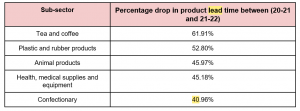Logistics
UK confectionery brands slash lead times by more than 40%

The company’s Product Lead Time Index used data from its inventory management software to track how product fulfilment has changed since the start of the pandemic.
Lead time is defined as the amount of time between when a purchase order is placed to replenish products and when the order is received in the warehouse. These times can vary between suppliers, where typically the more suppliers involved in the chain, the longer the lead time is likely to be.
Confectionery was one of the most affected sectors during the peak of the pandemic, with average delivery lead times in 2020/2021 growing by 61.3% since before the pandemic struck.
The analysis of more than 2,500 businesses and 25 different sub-sectors shows which ones experienced the most severe shortages during the Covid-19 crisis – and which recovered fastest as it subsided.
The sub sectors with the biggest reduction in lead times since the height of the pandemic are:
Commenting on the findings, Stephen Jones, Regional Manager UK & EMEA at Unleashed, said: “Global supply chains are complex, and while the market has been more uncertain than usual, our data suggests that suppliers are working hard to build resilience. In fact, for many, the crises have only strengthened their resolve. Given how much lead times have dropped in some sub-sectors including across plastics and rubber products, their efforts are clearly paying off.
“Keeping a tight rein on inventory is essential at any time but particularly during periods of disruption. When product lead times are fluctuating, the right technology can quickly show you the actual vs expected lead times which allows you to manage customer expectations, or look for alternative suppliers who can deliver faster.”










